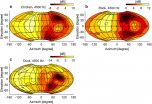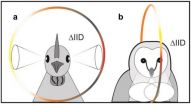(Press-News.org) Unlike mammals, birds have no external ears. The outer ears of mammals play an important function in that they help the animal identify sounds coming from different elevations. But birds are also able to perceive whether the source of a sound is above them, below them, or at the same level. Now a research team from Technische Universität München (TUM) has discovered how birds are able to localize these sounds, namely by utilizing their entire head. Their findings were published recently in the PLOS ONE journal.
It is springtime, and two blackbirds are having a sing-off. They are both competing for the attentions of a female. But to pick a successful suitor, the female must first be able to find him.
"Because birds have no external ears, it has long been believed that they are unable to differentiate between sounds coming from different elevations," explains Hans A. Schnyder from the TUM Chair of Zoology. "But a female blackbird should be able to locate her chosen mate even if the source of the serenade is above her."
Mammals identify sound sources in the vertical plane using their external ears, which absorb, reflect or diffract the sound waves because of their special structure. Their sense of hearing uses this information to determine the elevation of the sound source. But how do birds perceive these differences?
The head does the work of external ears
By studying three avian species - crow, duck and chicken - Schnyder discovered that birds are also able to identify sounds from different elevation angles. It seems that their slightly oval-shaped head transforms sound waves in a similar way to external ears.
"We measured the volume of sounds coming from different angles of elevation at the birds' eardrums," relates Schnyder. All sounds originating from the same side as the ear were similarly loud, regardless of their elevation. The ear on the opposite side of the head registered different elevations much more accurately - in the form of different volume levels.
Different volume levels reveal sound sources
It all comes down to the shape of the avian head. Depending on where the sound waves hit the head, they are reflected, absorbed or diffracted. What the scientists discovered was that the head completely screens the sound coming from certain directions. Other sound waves pass through the head and trigger a response in the opposite ear.
The avian brain determines whether a sound is coming from above or below from the different sound volumes in both ears. "This is how birds identify where exactly a lateral sound is coming from - for example at eye height," continues Schnyder. "The system is highly accurate: at the highest level, birds can identify lateral sounds at an angle of elevation from -30° to +30°."
Interaction between hearing and sight improves orientation
Why have birds developed sound localization on the vertical plane? Most birds have eyes on the sides of their heads, giving them an almost 360° field of vision. Since they have also developed the special ability to process lateral sounds coming from different elevations, they combine information from their senses of hearing and vision to useful effect when it comes to evading predators.
A few birds of prey like the barn owl have developed a totally different strategy. This species hunts at night, and like humans its eyes are front-facing. The feather ruff on their face modifies sounds in a similar way to external ears. The owl hears sounds coming from in front of it better than the other bird species studied by Schnyder.
So there is a perfect interaction between the information they hear and the information they see - as earlier studies were able to demonstrate. "Our latest findings are pointing in the same direction: it seems that the combination of sight and hearing is an important principle in the evolution of animals," concludes Schnyder.
INFORMATION:
Publication:
The Avian Head Induces Cues for Sound Localization in Elevation;
Hans A. Schnyder, Dieter Vanderelst, Sophia Bartenstein, Uwe Firzlaff and Harald Luksch; PLOS ONE, November 2014, DOI: 10.1371/journal.pone.0112178
More information:
Interview with Hans A. Schnyder "How birds do get by without external ears?" (YouTube): http://youtu.be/EXoFpL2G6UQ
Pictures for download: http://go.tum.de/069105
Contact:
Technische Universität München
Chair of Zoology
zoologie.wzw.tum.de
Hans A. Schnyder
phone: +49 8161 71-2806
hansa.schnyder@tum.de
Prof. Dr. Harald Luksch
phone: +49 8161 71-2801
harald.luksch@wzw.tum.de
NEW YORK, NY - Patients with operable kidney cancers were more likely to have a partial nephrectomy -- the recommended treatment for localized tumors -- when treated in hospitals that were early adopters of robotic surgery, according to a new study.
Researchers from NYU Langone Medical Center and elsewhere, publishing online December 11 in the journal Medical Care, report that by 2008, hospitals that had adopted robotic surgery at the start of the current century (between 2001 and 2004) performed partial nephrectomies in 38% of kidney cancer cases compared to late adopters ...
Novel research reveals that the risk of acute gout attacks is more than two times higher during the night or early morning hours than it is in the daytime. The study published in Arthritis & Rheumatology, a journal of the American College of Rheumatology (ACR), confirms that nocturnal attacks persist even among those who did not consume alcohol and had a low amount of purine intake during the 24 hours prior to the gout attack.
The body produces uric acid from the process of breaking down purines--natural substances in cells in the body and in most foods--with especially ...
Parkinson's disease sufferers have a different microbiota in their intestines than their healthy counterparts, according to a study conducted at the University of Helsinki and the Helsinki University Central Hospital (HUCH).
"Our most important observation was that patients with Parkinson's have much less bacteria from the Prevotellaceae family; unlike the control group, practically no one in the patient group had a large quantity of bacteria from this family," states DMSc Filip Scheperjans, neurologist at the HUCH Neurology Clinic.
The researchers have not yet ...
A team of researchers led by North Carolina State University has found that stacking materials that are only one atom thick can create semiconductor junctions that transfer charge efficiently, regardless of whether the crystalline structure of the materials is mismatched - lowering the manufacturing cost for a wide variety of semiconductor devices such as solar cells, lasers and LEDs.
"This work demonstrates that by stacking multiple two-dimensional (2-D) materials in random ways we can create semiconductor junctions that are as functional as those with perfect alignment" ...
Researchers have found new evidence that explains how some aspects of our personality may affect our health and wellbeing, supporting long-observed associations between aspects of human character, physical health and longevity.
A team of health psychologists at The University of Nottingham and the University of California in Los Angeles carried out a study to examine the relationship between certain personality traits and the expression of genes that can affect our health by controlling the activity of our immune systems.
The study did not find any results to support ...
Could there finally be tangible evidence for the existence of dark matter in the Universe? After sifting through reams of X-ray data, scientists in EPFL's Laboratory of Particle Physics and Cosmology (LPPC) and Leiden University believe they could have identified the signal of a particle of dark matter. This substance, which up to now has been purely hypothetical, is run by none of the standard models of physics other than through the gravitational force. Their research will be published next week in Physical Review Letters.
When physicists study the dynamics of galaxies ...
In the hunt for better knowledge on the aging process, researchers from Lund University have now enlisted the help of small birds. A new study investigates various factors which affect whether chicks are born with long or short chromosome ends, called telomeres.
The genetic make-up of our cells consists of genes lined up on chromosomes. The ends of the chromosomes are called telomeres, and they protect the chromosomes from sticking to each other. The longer the telomeres, the longer time the chromosomes are able to function. And conversely, the shorter these ends, ...
WEST LAFAYETTE, Ind. - Invasive plant and animal species can cause dramatic and enduring changes to the geography and ecology of landscapes, a study from Purdue University and the University of Kentucky shows.
A review of studies on how life forms interact with and influence their surroundings concluded that invasive species can alter landscapes in myriad ways and with varying degrees of severity. These changes can be quick, large-scale and "extremely difficult" to reverse, said study author Songlin Fei, a Purdue associate professor of quantitative ecology.
"Invaders ...
A species of small fish uses a homemade coral-scented cologne to hide from predators, a new study has shown, providing the first evidence of chemical camouflage from diet in fish.
Filefish evade predators by feeding on their home corals and emitting an odor that makes them invisible to the noses of predators, the study found. Chemical camouflage from diet has been previously shown in insects, such as caterpillars, which mask themselves by building their exoskeletons with chemicals from their food. The new study shows that animals don't need an exoskeleton to use chemical ...
Researchers at Loyola University Chicago Stritch School of Medicine may have identified a way to assess who is at risk for developing a urinary tract infection (UTI) following pelvic-floor surgery. These findings were reported in the latest issue of PLOS ONE.
Urinary tract infections (UTIs) are the most common type of bacterial infection and have estimated treatment costs exceeding $1 billion a year in the United States. Women who undergo surgery for pelvic-organ prolapse or urinary incontinence are more likely to develop a UTI following the procedure. Clinicians have ...



